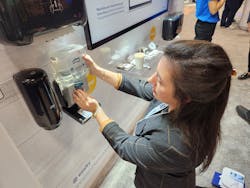Top Trends Impacting Restroom Specs (ISSA 2023)
No other area of a commercial building is riper for complaints than the restroom. From jammed machines to overflowing trash, it’s easy for things to go wrong—and when they do, it can impact your reputation.
The 2023 ISSA Show North America was packed with restroom innovations promising easier maintenance, more sustainable operation and more to keep your restrooms in top shape. These three trends that BUILDINGS found on the show floor could impact the way you specify restroom products.
1. The Labor Shortage
It’s tough to find enough people to clean your restrooms, so part of managing restroom maintenance is simply enabling the people you do have to work smarter and more efficiently. This means dispensers that hold more products, systems that are intuitive and uncomplicated, and better intelligence around when and where maintenance is needed.
At the ISSA Show North America, Tork highlighted all three, from a gravity-fed paper towel dispenser that holds 50% more towels than its competitors to Tork Vision Cleaning, a data-driven system that tracks supplies and lets facility managers know when something is running low.
“They get a dashboard of all the results in real-time, and they can put together cleaning plans that are specific and tailored to their facility and react almost instantaneously,” explained Rachel Olsavicky, Tork’s segment marketing manager for commercial and public interest. “If there’s a need, they can communicate directly to the cleaning staff and address it before it becomes a complaint.”
GP PRO’s new Compact Quad Plus toilet paper dispenser, which won ISSA’s Innovation of the Year award at the show, also targets the labor challenges that maintenance professionals are struggling with, said Ronnie Phillips, senior director of washroom innovation for GP PRO.
“We wanted to take the thinking out of refilling and maintaining our dispensers,” he added. “If you open it, it tells you exactly where to put the rolls. What we’re trying to do is allow them to focus on the job that needs to be done and not on how to use the dispensers. We want them to be so intuitive that when they open it, they know exactly what needs to be done.”
2. Increasing Sustainability Requirements
Sustainability is no longer a nice-to-have in many facilities—it’s a must-have. Manufacturers are answering the call with more sustainable products and manufacturing methods. Kimberly-Clark Professional highlighted its 2030 goals to reduce the company’s environmental impact around water, fiber and plastics by 50%.
The company also has a PPE recycling program called RightCycle in which previously hard-to-recycle items like protective clothing, nitrile gloves and safety glasses can now be recovered by the company, said Peter Leahy, marketing professional for Kimberly Clark Professional.
“We work with the customer to take that product, convert it into plastic pellets and then convert that into hard goods like shelving or Adirondack chairs,” Leahy said.
3. Hygiene and Cross-Contamination
VSI Health and Hygiene Group introduced a toilet paper dispensing system designed to “keep people safe from contaminated product that happens every day when the toilets are flushed in public restrooms,” explained Don Totten, chief sales and marketing officer. The dispenser keeps the toilet paper fully enclosed, and it’s only dispensed when the user inserts their hand into a recessed pocket on the dispenser—thus avoiding premature dispensing when the person is walking into the stall. The units will be available in Q2 of 2024, Totten said.
“The gap in the market right now is that every tissue dispenser has exposed tissue. Every one,” Totten said. “Whether it’s the big ones that are exposed underneath and people have to touch them to get the sheets, or it’s exposed right next to the toilet. This unit is going to revolutionize how we dispense toilet paper.”
About the Author
Janelle Penny
Editor-in-Chief at BUILDINGS
Janelle Penny has been with BUILDINGS since 2010. She is a two-time FOLIO: Eddie award winner who aims to deliver practical, actionable content for building owners and facilities professionals.

